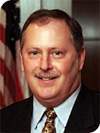Hiring Military Veterans is the Right Thing To Do

This month’s edition covers some new territory: In it is the report on the first-ever Military Industry Outlook, part of our Patriot Edition.
Given the fact that we’ve been conducting similar industry assemblies for more than 15 years, we were long overdue for a forum that would bring together high-ranking officers and executives who live in that nexus of military life and the business world.
And I have to tell you, it was an eye-opener.
Very few people who live or work in the greater Kansas City area are completely unaware of the presence of Fort Leavenworth, which lies just 22 miles northwest of Kansas City International Airport. But I was surprised to learn that the federal economic footprint—not just of the Command and General Staff College or the Combined Arms Center, but related organizations—was $5.5 billion a year for the Kansas City region.
I’ve always been aware of the presence of the fort, and we’ve conducted assemblies there and in collaboration with Leavenworth County that have referenced its impact. But that number was truly educational. And it’s just the tip of an iceberg in terms of overall federal defense installations in Missouri and Kansas.
With Whiteman Air Force Base less than an hour to the east, Fort Riley two hours to the west, and both McConnell Air Force Base in Wichita and Fort Leonard Wood roughly 200 miles away, Kansas City is cradled neatly in the middle of an impressive and influential collection of military installations that contribute many more billions to the regional economy.
The roles of those installations, however, could be changing. The Department of Defense has begun soliciting public commentary on the impact of force reductions, which are almost a certainty as the drawdown of forces continues in Afghanistan into 2016. By some estimates, as many as 1 million members of the service will be discharged over the next five years.
That’s almost a rounding error when you consider the 10.5 million who left the armed forces after World War II. But that cohort went on to become the most successful post-war group of veterans in the nation’s history, and gave rise to the great American middle class. With the backing of the GI Bill, many went to college then headed into the work force or into business ownership with a fearless, can-do attitude.
One significant difference between then and now: The U.S. tipped the balance of World War II largely because of our wealth of resources, both in material and manpower. Simply put, we defeated the Axis power by producing a bigger war machine with brute numbers.
This time around, it’s a different military. The all-volunteer structure of the armed forces over the past two generations, combined with investment in technology, has yielded a better-educated military, on the whole, and a more skilled one.
Amid all of that, two questions: Will new twists on federal education aid to veterans produce the same infusion of talent and attitude into the modern work force? And will employers in Kansas and Missouri be poised to take advantage of this extraordinary talent pool?
I ask that because the 1 million figure included a large number of career military officers, not just younger servicemen and women. The talent pool being discharged from the armed forces due to the drawdown is providing people who have been in charge of others, in cases hundreds—thousands, even—of those employed by the Pentagon. They have extraordinary administrative skills, a keen understanding of things both tactical and strategic, a drilled-in respect for authority, and—this is important—deep history of both giving and following orders.
Think about that: Aren’t those the skills that most of us in business yearn for in a new employee?
There’s one thing about veterans that all of us should consider as hiring authorities: I wouldn’t argue that someone’s military service should be the prime determinant in their qualifications for employment, but all other factors being equal, everyone in this country owes veterans a debt of gratitude. If that can be expressed with employment, where the skill sets match the job requirements, all the better.
I’ve thought about that debt a lot since our military round-table. One of the attendees, retired Gen. Robert Arter, spoke about having attended the funeral of a soldier who died in combat in Afghanistan—on his ninth deployment in the war on terror. The sacrifices that soldier made—before making the ultimate one—and those that his family made during each of those overseas missions should be humbling to every one of us.
So we’re at one of those rare periods where a unique opportunity is being presented to us. How will we as responsible employers and citizens respond?

Joe Sweeney
Editor-In-Chief & Publisher